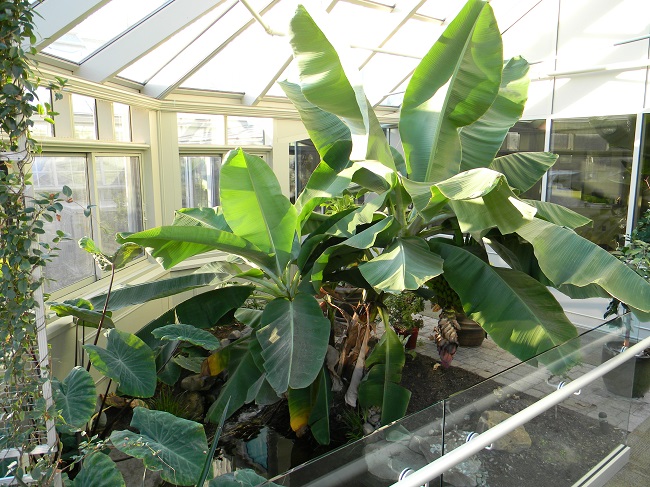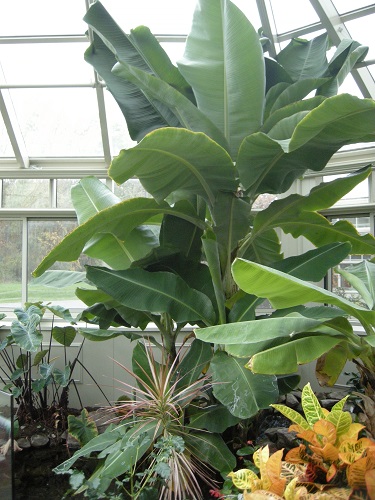
Most people have eaten a banana, but I doubt many have ever eaten a banana straight off the tree. If you are greenhouse user and the greenhouse has heat in the winter, then you need a banana tree. It is an easy plant to grow in a greenhouse and incredibly exciting when you can pull a ripe banana straight off the tree.
There are two items that you must have to grow a banana: Space and heat.
Space
Most banana trees are tall and take up a lot of space. The height can grow upwards of twenty feet and expand to ten feet in width. If you live in the south and have an ample backyard this is probably not a severe issue. If the banana is going into a greenhouse, it could easily consume most of your greenhouse. Do not fear there are dwarf varieties. A dwarf version will allow you to grow a banana tree that produces fruit while being contained in a compact container.
Heat
Banana trees are tropical plants which mean they absolutely need heat. Temperatures under seventy degrees F. will stunt their growth. At night the temperature can drop, but it is imperative that daytime temperatures remain above seventy degrees. The bananas will continue to grow and thrive when their environments reach eighty to ninety degrees during the summer.

You can plant your banana tree in a container. A dwarf type will do well in a container, but a large banana tree will most likely never reach its full potential. I have a banana tree which is around 10-12’ in height and I planted an offshoot in a container. The containerized plant has never reached more than four feet. It has been my finding that all plants do better in a raised bed, in the ground, than they do in a container. When they are grown in a container the soil must be able to drain well so most people add a copious amount of perlite.
Another method for growing the banana tree is to try raising it in a pond. The banana will love the water. Plant the banana on the “bank” of the pond and allow the roots to find the water. By the time the banana reaches maturity the pond will have a cascade of banana roots. Inside our greenhouse we have bananas growing in this situation and there are koi fish in the pond. Everything I have ever read says that bananas are heavy feeders and need monthly fertilizing for fruit production. My bananas growing in the pond have never been fertilized by anything other than the koi and they are thriving. If your bananas are growing in a container, they should be fertilized regularly with compost or a citrus fertilizer.
As the tree grows it gives off pups or offshoots, which steal nourishment from the main tree. You will need to stay on top of the newcomers and remove the pups as they grow. After a tree gives fruit, it dies, and the next generation takes its place. For this to happen you must pick one pup and save it, allowing it to grow, but removing all the others. When you divide the pups, you can try to pot one in a container, or plant another one in a raised bed and continue the cycle. Eventually your banana tree will bloom like all other citrus plants. But unlike a lemon or a kumquat which produce hundreds of blooms, a banana tree only gives one flower that is nothing beautiful to look at. The flower looks like a long tube, with different layers (petals), and is burgundy in color. The bloom comes from the top of the tree and hangs downwards, virtually growing upside down. Each petal peels backwards and a row of bananas emerge, then the next petal peels back and another set of bananas emerge. This continues until you have around sixty bananas. Now you just need to be patient for several months and allow the fruits to ripen. Our trees always give us fruit over winter, so it is exciting to bring friends to the tree and show them bananas in the middle of a snowstorm. Our first banana tree took two years to bloom, but now every fall the new tree supplies us with a bloom.
You will notice that as the fruits ripen, the tree begins to die, and it may even be necessary to prop up the tree. It always seems that our bananas want to fall into the walkway as they die. To prevent this, we have a cable attached to the greenhouse rafters that holds the bananas upright. It seems like a lot of work, but it is worth it. Last year we had a banana that was about half the size of the mother, somewhere around 5’ and it bloomed, kind of a rarity I have heard. We thought the tree would be fine as the fruit developed. I came into the greenhouse one morning, only to find the banana tree split in half and floating in the pond. The bunch of bananas became too heavy for the tree, and it broke in two pieces. Learn from my example and prop up your tree with stakes or a cable.
Another hiccup that we have experienced is an attack of scale on the tree as it dies. The fruits begin to suck all the nourishment out of the tree, and it becomes susceptible to diseases. Last year our tree was ravaged with scale growing on every leaf, all the way to the top. There was no way I was going to put a ladder in the pond and try to clean the leaves at the top. I was constantly cleaning the leaves at ground level so they would look presentable. Finally, the bananas turned bright yellow, and we picked them. That same week the tree, and all its scale, came down and was thrown outside to die in the cold.
I wanted to prevent this from happening again, so we installed circulating fans in the greenhouse to keep the air moving because stagnant air breeds disease. I also have been trimming banana tree leaves so that air can move between all the leaves. Our sick tree had leaves touching each other creating an environment where the scale bred. By preventing leaves from touching each other it is harder for pests to spread. Even if your banana does not have pests, it still must come down after fruiting.
When you remove the banana tree, it is much easier to cut off the leaves first which makes it easier to carry the tree out the doors of the greenhouse. Then cut the tree’s trunk into sections so it is easier to handle. Because our greenhouse has a pond, we like the stumps to fall into the water so we can then catch it (the trunk floats) and pull it through the raised bed and quickly out the door without staining the anything. The last step is to dig out the stump and remaining roots.
It is also worth noting that you can pick green bananas and fry them for a tasty treat. Banana leaves can also be used for cooking. Many people will roast vegetables and meat inside the banana leaves.
Lyndsey Roth is an experienced gardener and greenhouse grower.
Related Articles & Free Email Newsletter Sign Up
How to Grow Pineapple in a Greenhouse




Comment here